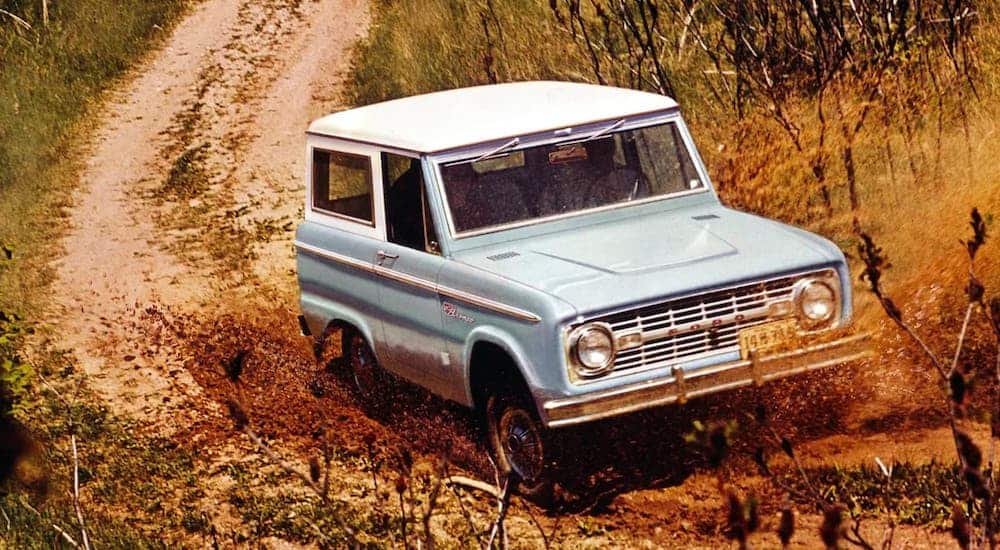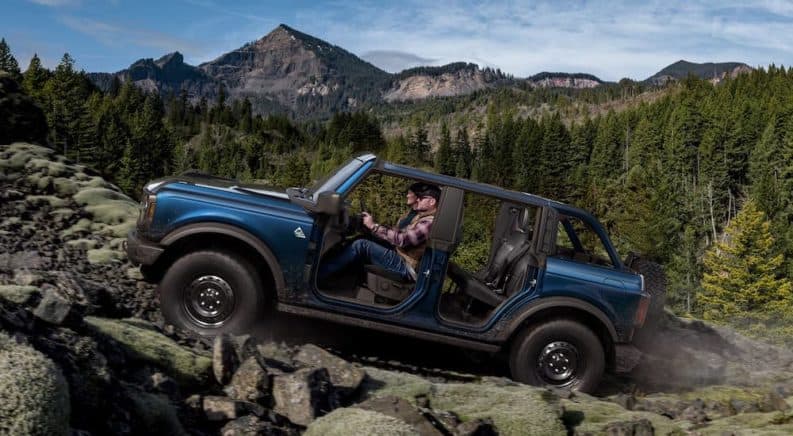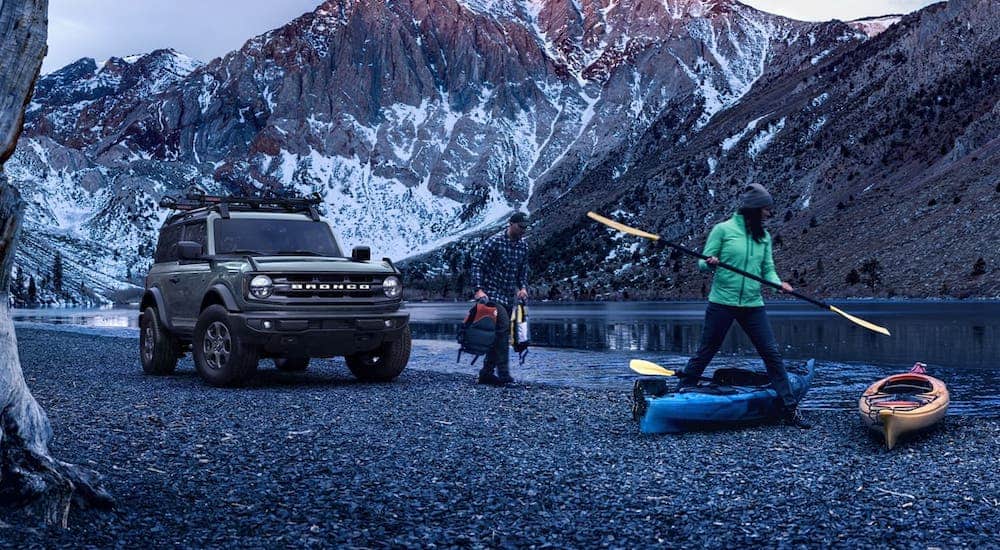It’s only possible to see how far we’ve come when we take time to reflect and look back. Nowhere is this more evident than when we consider the evolution of an icon: namely, the all new 2021 Ford Bronco vs 1966 Ford Bronco, where the story began. Appreciation for the importance of this evolution begins with the story of how the Bronco was first launched and carries through to the present day. This newest Bronco marries tradition with technology, borrowing the best parts of its roots and overlaying that core Bronco foundation with today’s newest advances in automotive engineering.
We waited patiently while Ford teased us with the re-release of the new 2021 Bronco, and were rewarded with a Bronco and Bronco Sport model lineup that embodies the adventurous, off-roading spirit with which the Bronco has always been associated. Sometimes you can’t improve on an original (example: New Coke), but in this case, we think Ford has a blockbuster on its hands. From styling to capability, this new Ford Bronco has automotive journalists and off-roaders alike chomping at the bit to get a taste of all it has to offer.
Ford recently started allowing customers to reserve a 2021 Bronco, and some trims are already sold out. The company anticipates that the first Broncos will reach showroom floors by June 2021; however, Ford also announced that – due to the high volume of demand and reservations – deliveries might extend into 2022. If that doesn’t tell you how excited the off-roading public is about the Bronco’s reappearance, read on for the highlights.
History of The Bronco

The Bronco was first devised by Ford in 1965 as an off-roading vehicle and was Ford’s very first SUV. It was designed in four-wheel drive only and competed directly with the Jeep CJ-5 (what we know today as the Wrangler) and the International Scout. Introduced as a 1966 model year utility vehicle, the Ford Bronco had a two-door body style and included an inline six-cylinder engine and only a three-speed manual transmission and manual transfer case with manual locking hubs. It was only in 1973 that an automatic transmission became available.
In 1978, Ford transitioned the Bronco into a full-size model so it could compete with the Chevy Blazer and other larger SUVs. Later, in 1984, the company introduced the Ford Bronco II, a smaller version of the Bronco. It seemed that Ford was chasing different market segments for the first two decades of the Bronco’s production years rather than settling in on a specific identity for the Bronco nameplate. Lucky for us, this indecision has led to a different strategy for 2021.
By contrast, the 2021 Ford Bronco is being released in two different models: the Bronco and the Bronco Sport, and both are positioned uniquely to appeal to different buyers. In 1965, Ford slated the Bronco specifically for off-roaders. In this newer version, Ford expands the appeal to a much broader spectrum of new vehicle buyers. The 2021 Bronco more closely resembles its earlier version, with two- and four-door body styles and a wide range of trims, including bare-bones trims with stripped interiors. The Bronco Sport is smaller and only available in a four-door body style. It’s much more of an everyday crossover SUV, and Ford hopes to draw in Bronco fans that don’t quite need the gritty, rugged design of a larger, full-blown off-roader.
For the purposes of comparison, we will focus on the 1966 Bronco vs 2021 Bronco and set aside the Bronco Sport.
Powertrain
The 1966 Ford Bronco was a simple machine. Ford designed it this way for a very narrow target customer. That customer was seeking a utility off-roader. Back in the 60s, this moniker wasn’t as widespread, so a sport utility vehicle was just that: a vehicle designed for basic utility. In the Bronco’s case, this was off-roading. Today, the term ‘sport utility vehicle’ refers to a broad range of vehicles, including crossovers, large SUVs, luxury imports, and even electric vehicles.
The ’66 Bronco came standard with a 170-cubic inch inline six-cylinder engine which delivered a scant 105 horsepower. Midway through the 1966 model year, Ford began offering a 200 horsepower V8, which was 289-cubic inches. Only the 3-speed manual transmission was available throughout the 1966 model year.
By contrast, the 2021 Bronco offers several state-of-the-art engine and transmission configurations, including a 2.7 liter EcoBoost engine that, when paired with four-wheel drive, will provide 310 horsepower and 400 lb-ft of torque, which Ford claims is best-in-class. Also available is a standard 4-cylinder 2.3 liter EcoBoost engine that delivers 270 horsepower and 310 lb-ft of torque. In addition, the Bronco offers a 7-speed manual transmission (one gear is for crawling), which is also a first in the category. Ford’s 10-speed automatic transmission grinds out the low gears and is the only 10-speed transmission in its class.
As for 4×4 capabilities, the Bronco offers an Electronic Shift-On-The-Fly (ESOF) two-speed transfer case with three modes: 4H and 4L, for full-time four-wheel drive; 4L, for specific road and off-road conditions that require more torque; and Neutral, for flat towing. These powertrains incorporate Ford’s Go Over Any Terrain (G.O.A.T.) performance standard.
Bronco Trims
In 1966, Ford didn’t offer too many bells and whistles, and the idea of an expansive trim lineup wasn’t really popular. Instead, Ford offered the Bronco as an all-purpose vehicle without a roof or doors. Doors were available as an option with or without glass and a frame. The Bronco was also available with vinyl doors and a convertible top, and the windshield folded flat onto the hood for a true open-air driving experience. Inside, customers got a bench seat or could opt for two bucket seats or even just one. Eventually, several add-on packages became available, but not until later model years.
Today, customers have a variety of options when choosing their 2021 Ford Bronco. The Base, with a starting MSRP of $28,500 for the two-door and $33,200. T Big Bend, at $33,385 for the two-door and $35,880 for the four-doo. The Black Diamond comes in at an MSRP of $36,050 for the two-door and $38,545 for the four-door. The Outer Banks, at $38,995 for the two-door and $41,450 for the four-door. The Badlands, starting at $42,095 for the two-door and $44,590 for the four-door. The Wildtrak comes in at $48,875 for the two-door and $51,370 for the four-door. Last but not least, the First Edition, at $59,305 for the two-door and $63,500 for the four-door. This is Ford’s most expensive Bronco, with only 3,500 available (and already spoken for).
Clearly, a lot has changed in the 55 years since Ford first released the Bronco, but a lot has stayed the same. The Bronco name still inspires adventure and ignites the passion of loyal followers everywhere who have already scooped up the first handful of vehicles coming available next year. It’s fair to say that customers cannot wait to get behind the wheel and experience the legacy and iconic feel of the reborn and reimagined Ford Bronco. We expect the 2021 Bronco and Bronco Sport to shake up the balance in their respective categories and – most importantly – live up to the Ford Bronco name.





